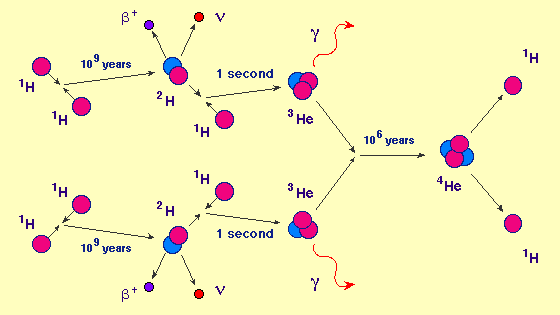There are two sequences of reactions that can convert hydrogen to helium and
thereby release energy that are important in stars.
- The Proton-Proton or PP Chain, which is important in stars the mass of the Sun
and less.
- The CNO cycle, which is important in more massive stars
We discuss the PP chain in this section and the CNO cycle in the next.
Reactions of the PP Chain
The primary reactions in the main branch of the PP chain are illustrated in the
following figure. (There are other less important branches of this chain that we
shall ignore in our discussion).
 |
|
Main branch of the proton-proton chain.
|
The main branch of the PP chain consists of the following reactions:
- Two mass-1 isotopes of hydrogen undergo a simultaneous fusion and beta decay
to produce a positron, a neutrino, and a mass-2 isotope of hydrogen (deuterium).
-
The deuterium reacts with another mass-1 isotope of hydrogen to produce Helium-3
and a gamma-ray.
-
Two helium-3 isotopes produced in separate implementations of
steps (1) and (2) fuse to form a
Helium-4 nucleus plus two protons.
The net effect is to convert hydrogen to helium, with the energy released going
into the particles and gamma-rays produced at each step of the sequence.
Rates for the PP Chain
The average time required for a nucleus to undergo each step of this sequence in a
typical stellar interior is indicated in the figure shown above.
Thus, for example, a
hydrogen nucleus waits on the average 1 billion years before it undergoes
an interaction with another hydrogen nucleus to initiate the sequence!
Since all other steps require
much less time than this, it is this initial step that controls the rate of the
reaction.
This incredibly small rate nevertheless accounts for the luminosities of
normal stars because there are so many hydrogen atoms in the core of a star that at
any one instant many are undergoing the reactions of the PP chain.

